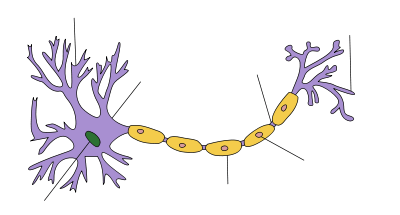Saltatory conduction
| Saltatory conduction occurs only on myelinated axons. |
|---|
- For Saltation definition, see Saltation (biology)
Saltatory conduction (from the Latin saltare, to hop or leap) is the propagation of action potentials along myelinated axons from one node of Ranvier to the next node, increasing the conduction velocity of action potentials without needing to increase the diameter of an axon.
Mechanism
Because the cytoplasm of the axon is electrically conductive, and because the myelin inhibits charge leakage through the membrane, depolarization at one node of Ranvier is sufficient to elevate the voltage at a neighboring node. Thus, the voltage at the first node of Ranvier extends spatially to the next node of Ranvier. At each successive node, the membrane potential of the axon is thereby brought to the threshold potential to initiate an action potential. Ions need only to cross the axon membrane to propagate the action potential at the nodes, but not anywhere under the myelin along the axon. Thus in myelinated axons, action potentials do not propagate continuously as waves, but instead recur at successive nodes, and in effect "hop" along the axon, by which process they travel faster than they would otherwise. (The action potential only moves in one direction, because the sodium channels at the previous node of Ranvier are inactivated, and cannot regenerate another action potential, even when depolarized.) In summary, the charge will passively depolarize the adjacent node of Ranvier to threshold, triggering an action potential in this region and subsequently depolarizing the next node, and so on. This phenomenon was discovered by Ichiji Tasaki[1][2] and Andrew Huxley[3] and their colleagues.
Energy efficiency
Apart from increasing the speed of the nerve impulse, the myelin sheath helps in reducing energy expenditure at the area of depolarization and hence the amount of sodium/potassium ions that need to be pumped to bring the concentration back to normal, is decreased. [citation needed]
Distribution
Saltatory conduction had been found exclusively in the myelinated nerve fibers of vertebrates, but was later discovered in a pair of medial myelinated giant fibers of Fenneropenaeus chinensis and Marsupenaeus japonicus,[4][5][6] as well as a median giant fiber of an earthworm.[7] Saltatory conduction has also been found in the small- and medium-sized myelinated fibers of Penaeus shrimp.[8]
See also
- Electrophysiology
- Ephaptic coupling
- Goldman equation
- GHK current equation
- Hodgkin-Huxley Model
- Neurotransmission
- Myelin
- Quantitative models of the action potential
- Patch clamp
- Cable theory
- Hindmarsh-Rose model
- Bioelectrochemistry
References
- ↑ Tasaki, I. The electro-saltatory transmission of the nerve impulse and the effect of narcosis upon the nerve fiber. Am J Physiol 127: 211-227, 1939
- ↑ Tasaki, I. and Takeuchi, T. Der am Ranvierschen Knoten entstehende Aktionsstrom und seine Bedeutung für die Erregungsleitung. Pflügers Arch ges Physiol. 244: 696-711, 1941
- ↑ Huxley AF, Stämpfli R. Evidence for saltatory conduction in peripheral myelinated nerve fibres. J Physiol. 108:315-39, 1949. PMID 16991863
- ↑ Hsu K, Tan TP, Chen FS. On the excitation and saltatory conduction in the giant fiber of shrimp (Penaeus orientalis). Proceedings of the 14th National Congress of the Chinese Association for Physiological Sciences. 1964, Aug. 7-15, Dalian, p. 17
- ↑ Hsu K, Tan TP, Chen FS. Saltatory conduction in the myelinated giant fiber of shrimp (Penaeus orientalis). KexueTongbao 20:380-382, 1975
- ↑ Kusano K, La Vail MM. Impulse conduction in the shrimp medullated giant fiber with special reference to the structure of functionally excitable areas. J Comp Neurol. 142:481-494, 1971
- ↑ Gunther J. Impulse conduction in the myelinated giant fibers of the earthworm. Structure and function of the dorsal nodes in the median giant fiber. J Comp Neurol. 168:505-531, 1976
- ↑ Xu (Hsu) K, Terakawa S. Saltatory conduction and a novel type of excitable fenestra in shrimp myelinated nerve fibers. Jap J Physiol. 43 (suppl. 1), S285-S293
